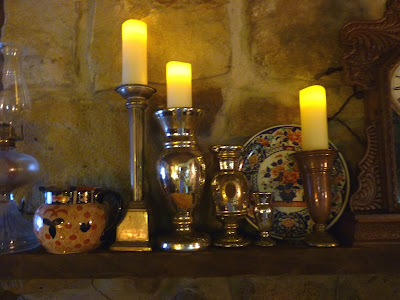Mercury glass, also called silver glass, has made a bit of a comeback in recent years. I see it in Walmart and other stores as candleholders and other decor. Its bright silver shine is certainly attractive. In my childhood, we had many mercury glass Christmas ornaments, most of them made in Germany or other European countries. in the mid-1800's.
 |
| Two mercury glass candle holders or vases, along with one of the copper vases we found in Wales, and a tall silverplate candleholder that could really use cleaning...again. |
I can imagine the delight of housekeepers in the 1800's when this glass came out. The shine and look of silver, without tarnish and polishing? Yes, please! Of course, being glass was a certain drawback as glass breaks and silver doesn't.
What is mercury glass exactly? Wikipedia says it is "glass that was blown double walled, then silvered between the layers with a liquid silvering solution, and sealed. Although mercury was originally used to provide the reflective coating for mirrors, elemental mercury was never used to create tableware. Silvered glass was free-blown, then silvered with a solution containing silver nitrate and grape sugar (!) in solution, heated, then closed. Sealing methods include metal discs covered with a glass round or a cork inserted into the unpolished pontil scar. "Mercury" silvered glass was produced originally around 1840 until at least 1930 in Bohemia (now the Czech Republic), Germany and was also manufactured in England from 1849 to 1855. Edward Varnish and Frederick Hale Thomson patented the technique for silvering glass vessels in 1849....Silvered "mercury" glass is considered one of the first true "art glass" types, that is, glass that was made for display and for its inherent artistic value rather than for utilitarian use."
It is easy to distinguish old mercury glass from the new variation; the old pieces will be double-walled, and will have a pontil, which is the mark made on glass where the glassblowing rod is disattached from the piece after blowing. Here's one example of a pontil on mercury glass:
The hole in the bottom of mine are not sealed. Whatever they had in the pontil hole is long gone. In most blown glass, the pontil is not open, but I suppose the hole was left in this double-walled glass for the silvering to be applied.
The biggest problem with this glass is that the silvering comes loose with age. All but one of the pieces I bought are losing some of their silvering. Most had some painting on them, flowers and gold bands, but that too has worn away with age until there is little left of the original design.
 |
| I sure wish the cameo on this piece wasn't so faded. |
Still, displayed on the mantle they are quite pretty, aren't they?
The age of these pieces and their wear give them a distinctive look to me. I've listed all of these on ebay for a reasonable price, but if they never sell, I'm okay with that. I will enjoy them as long as they're here.
Copyright Susanna Holstein. All rights reserved. No Republication or Redistribution Allowed without attribution to Susanna Holstein.




I like this type of glass and it looks like you bought a good lot.
ReplyDeleteMichelle, it was $2 for 8 pieces, so I was happy with it. Worth that just to learn about this unusual glass.
ReplyDeleteThis comment has been removed by a blog administrator.
ReplyDeleteThanks for sharing the info on mercury glass. Who knew!
ReplyDeleteI like mercury glass, and have used the modern craft stuff to silver things, but it really isn't the same as the old stuff.
Looks like you got a good deal, and I wouldn't blame you a bit for keeping them.